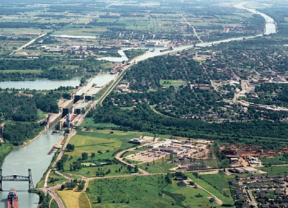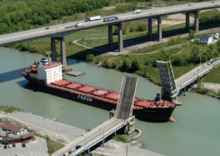
Back قناة ويلاند ARZ Wellandkanoi BAR Welland (kanál) Czech Wellandkanal German Kanalo Welland Esperanto Canal Welland Spanish Wellandin kanava Finnish Canal Welland French Longchanáil Welland Irish תעלת ולנד HE
| Welland Canal | |
|---|---|
 | |
 | |
| Specifications | |
| Length | 27 miles (43 km) |
| Maximum boat length | 740 ft 0 in (225.6 m) |
| Maximum boat beam | 78 ft 0 in (23.8 m) |
| Maximum boat draft | 26.5 ft (8.08 m) |
| Locks | 8 |
| Status | Open |
| Navigation authority | Saint Lawrence Seaway Management Corporation |
| History | |
| Original owner | Welland Canal Company |
| Principal engineer | Hiram Tibbetts |
| Construction began | 1824 |
| Date completed | November 30, 1829 |
| Date extended | 1833 |
| Date restored | August 6, 1932 |
| Geography | |
| Start point | Lake Ontario at Port Weller (St. Catharines) |
| End point | Lake Erie at Port Colborne |



The Welland Canal is a ship canal in Ontario, Canada, and part of the St. Lawrence Seaway and Great Lakes Waterway. The canal traverses the Niagara Peninsula between Port Weller on Lake Ontario, and Port Colborne on Lake Erie, and was erected because the Niagara River—the only natural waterway connecting the lakes—was unnavigable due to Niagara Falls. The Welland Canal enables ships to ascend and descend the Niagara Escarpment, and has followed four different routes since it opened.
The Welland Canal[1] passes about 3,000 ships which transport about 40 million tonnes (88 billion pounds) of cargo a year. It was a major factor in the growth of the city of Toronto, Ontario.[2] The original canal and its successors allowed goods from Great Lakes ports such as Cleveland, Detroit, Milwaukee, and Chicago, as well as other heavily industrialized areas of the United States and Ontario, to be shipped to the Port of Montreal or to Quebec City, where they were usually reloaded onto ocean-going vessels for international shipping.
Since its initial opening on November 30, 1829, the canal has been reconstructed numerous times to accommodate larger vessels and provide for quicker navigation. The First Welland Canal was excavated between 1824 and 1829, and operated until 1845. The Second Welland Canal, built between 1841 and 1845, had locks made of stone rather than wood, and had greater width and depth that the First Canal; it remained in operation for nearly a century before closing permanently in 1935. The Third Welland Canal, built between 1872 and 1877, was deeper and wider still and cut a straighter path through the escarpment, and featured 26 masonry locks lined with wood to protect ships rubbing against the sides or bottom; it too operated until 1935. The Fourth Welland Canal began construction in 1913 and, after a delay due to World War I, was eventually completed in 1932; deeper and wider than the Third Canal, its opening permitted two large ships to pass going in opposite directions, and it featured only eight locks, as compared with the 40 locks of the First Canal. It remains in operation to this day.[3]
The Welland Canal eclipsed[citation needed] other, narrower canals in the region, such as the Trent-Severn Waterway and, significantly, the Erie Canal (which linked the Atlantic and Lake Erie via New York City and Buffalo, New York) by providing a shorter, more direct connection from Port Colbourne on Lake Erie to Port Weller on Lake Ontario.
The southern, Lake Erie terminus of the canal is 99.5 metres (326 feet) higher than the northern terminus on Lake Ontario. The canal includes eight 24.4-metre-wide (80 ft) ship locks.[4] Seven of the locks (Locks 1–7, the 'Lift' locks) are 233.5 m (766 ft) long and raise (or lower) passing ships by between 13 and 15 m (43 and 49 ft) each. The southernmost lock, (Lock 8 – the 'Guard' or 'Control' lock) is 349.9 m (1,148 ft) in length.[1] The Garden City Skyway passes over the canal, restricting the maximum height of the masts of the ships allowed on this canal to 35.5 m (116 ft).
All other highway or railroad crossings of the Welland Canal are either movable bridges (of the vertical lift or bascule bridge types) or tunnels. The maximum permissible length of a ship in this canal is 225.5 metres (740 feet). It takes ships an average of about eleven hours to traverse the entire length of the Welland Canal.
- ^ a b "The Welland Canal – Navigation, Locks, Distances, and Passage Information". Archived from the original on July 10, 2017.
- ^ "225 Years of Port Activity". PortsToronto.
- ^ "The Welland Canals – History".
- ^ "Great Lakes St. Lawrence Seaway System – The Welland Canal Section of the St. Lawrence Searey" (PDF). Archived (PDF) from the original on November 19, 2012.